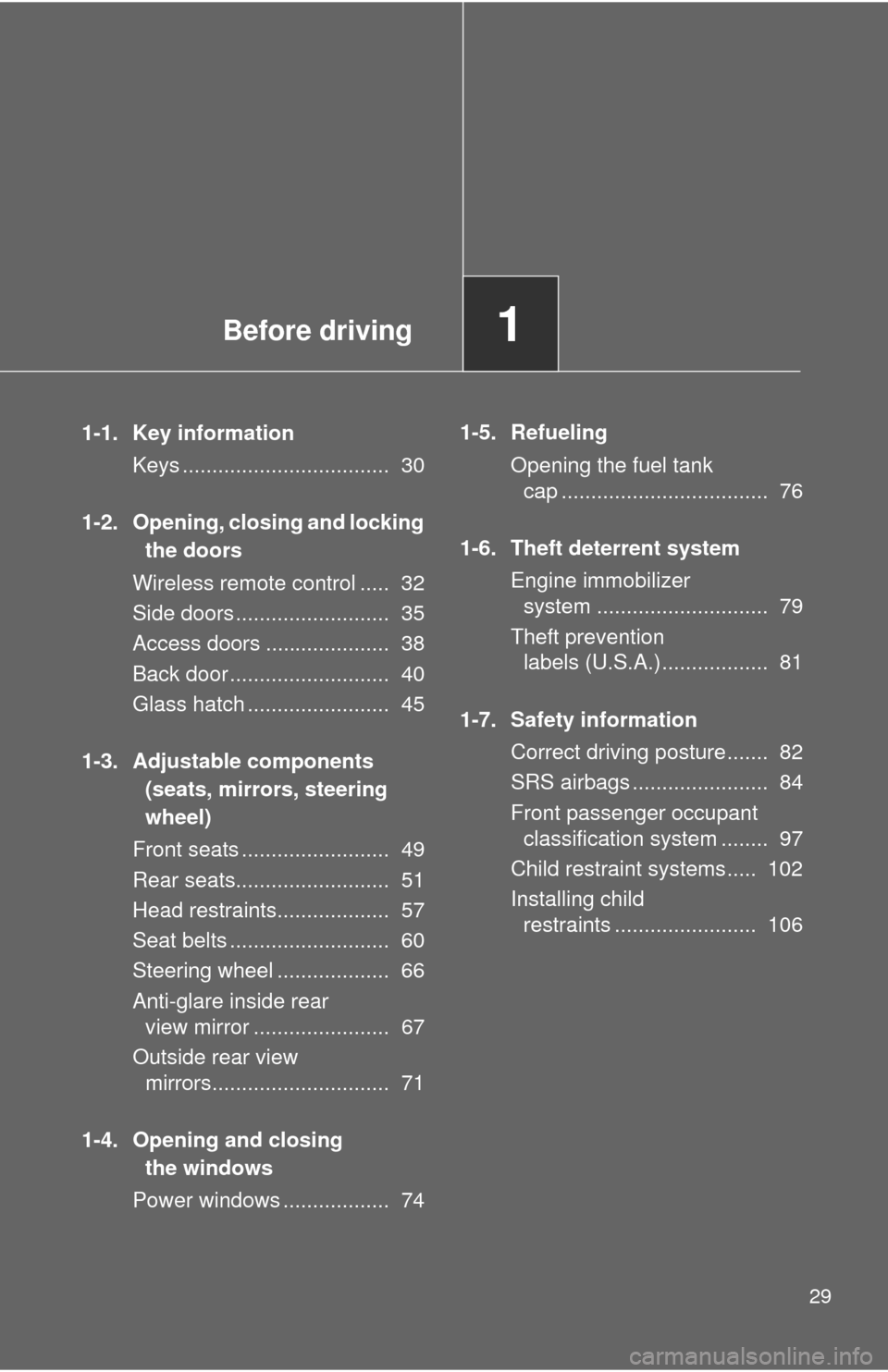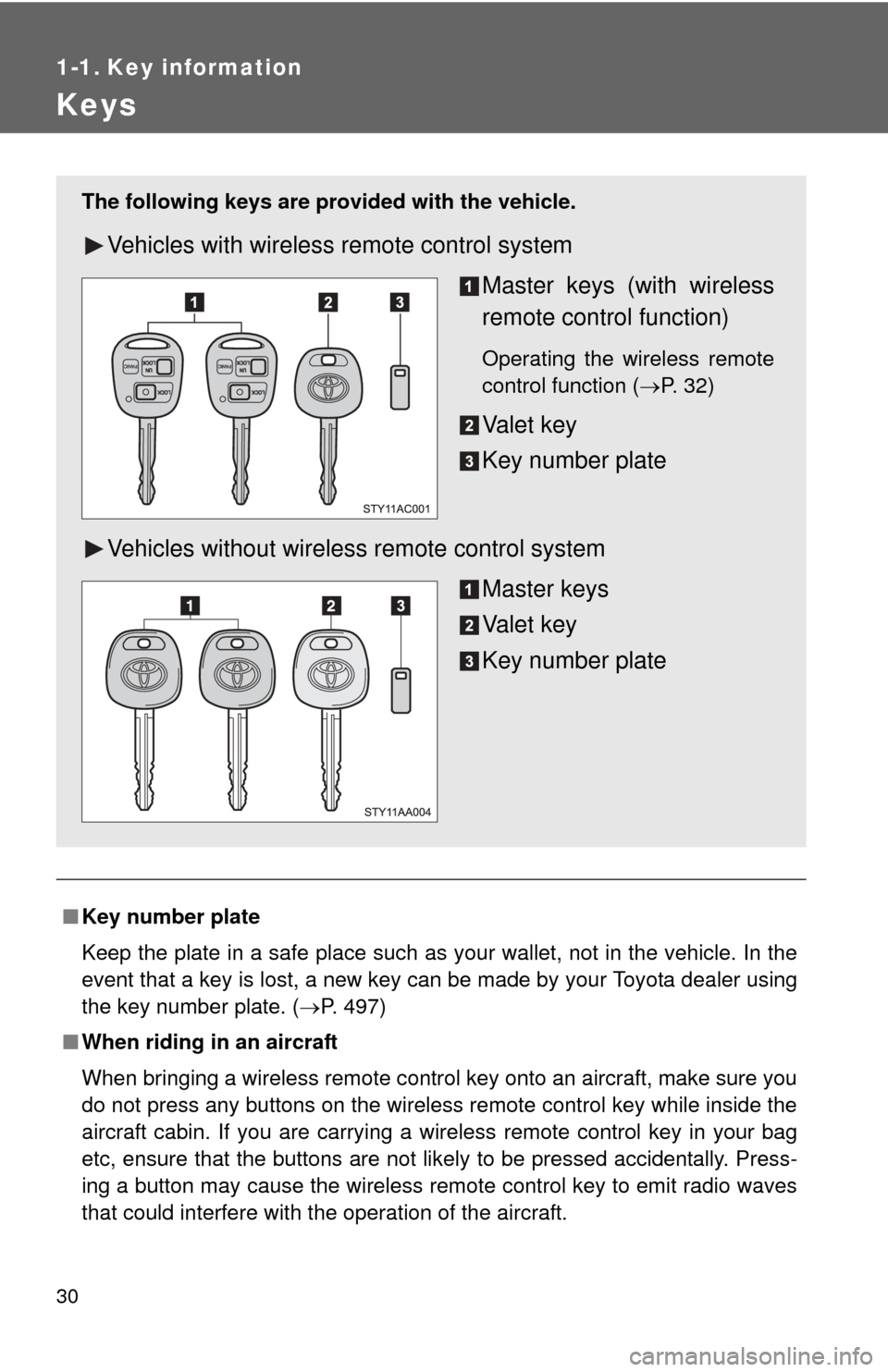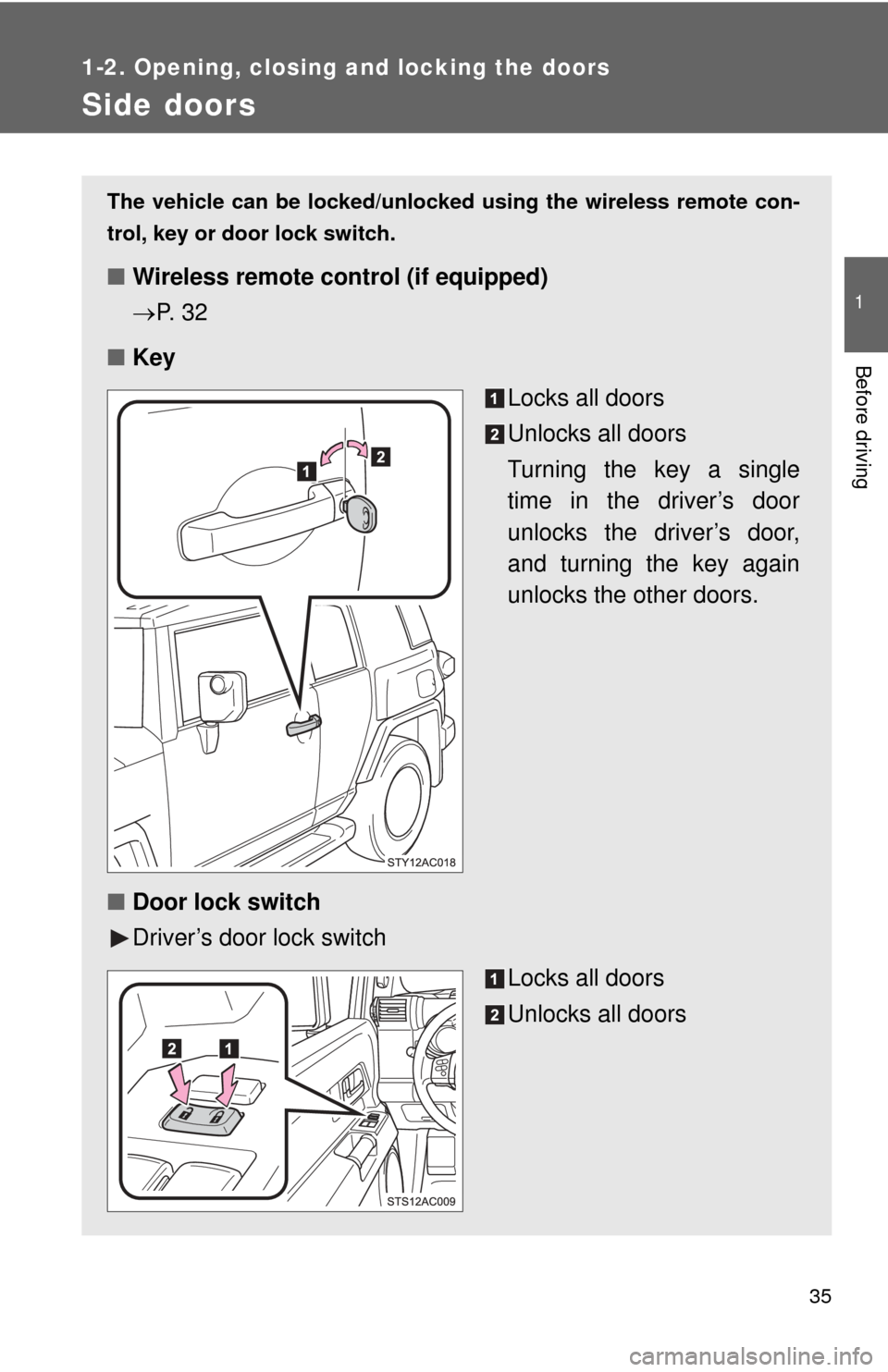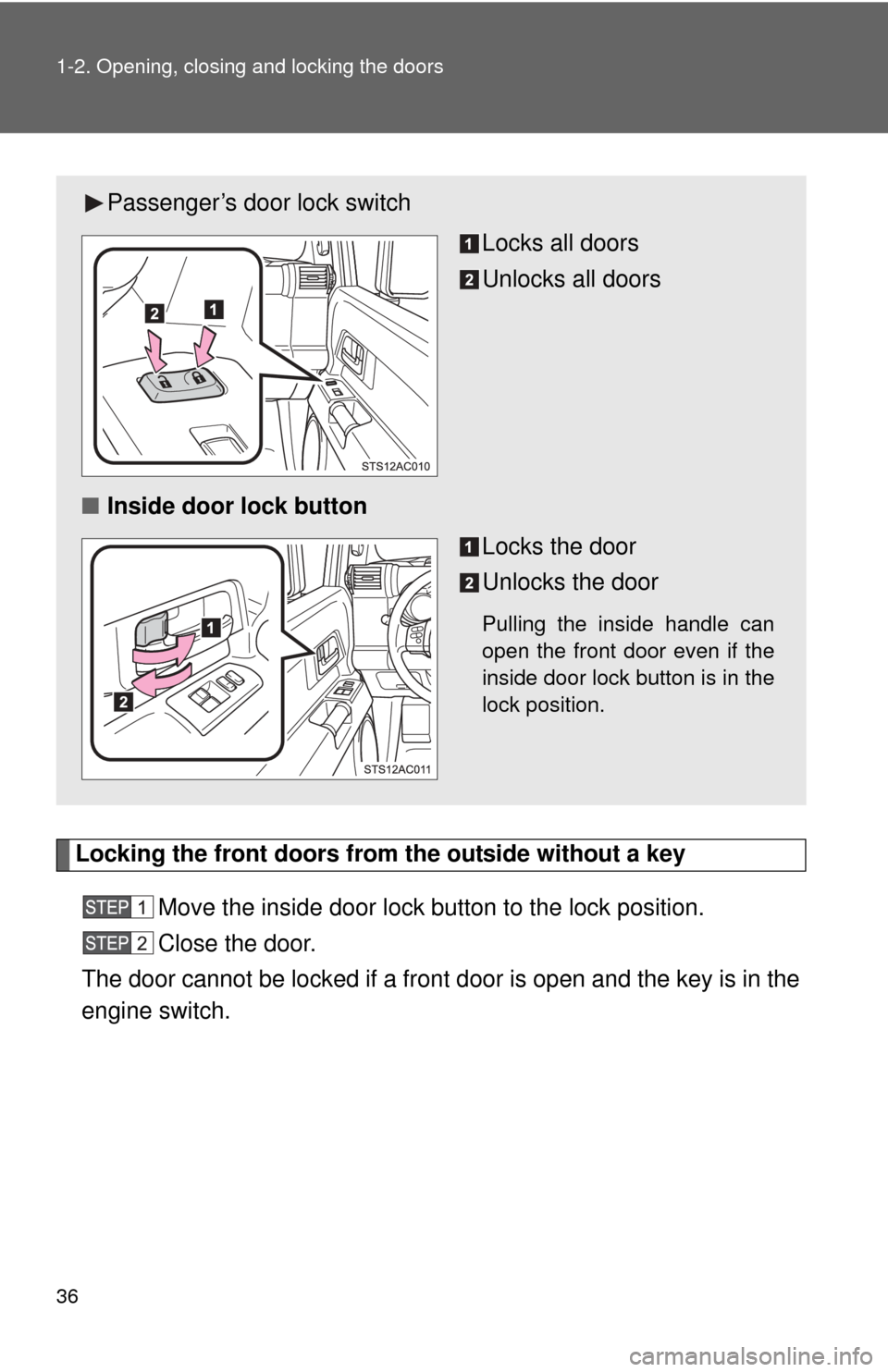key TOYOTA FJ CRUISER 2013 1.G Owners Manual
[x] Cancel search | Manufacturer: TOYOTA, Model Year: 2013, Model line: FJ CRUISER, Model: TOYOTA FJ CRUISER 2013 1.GPages: 568, PDF Size: 9.49 MB
Page 2 of 568

TABLE OF CONTENTSIndex
2
1-1. Key informationKeys ..................................... 30
1-2. Opening, closing and locking the doors
Wireless remote control ....... 32
Side doors ............................ 35
Access doors........................ 38
Back door ............................. 40
Glass hatch .......................... 45
1-3. Adjustable components (seats, mirrors, steering
wheel)
Front seats ........................... 49
Rear seats ............................ 51
Head restraints ..................... 57
Seat belts ............................. 60
Steering wheel ..................... 66
Anti-glare inside rear view mirror .................................. 67
Outside rear view mirrors ..... 71
1-4. Opening and closing the windows
Power windows .................... 74
1-5. Refueling Opening the fuel tank cap .... 76 1-6. Theft deterrent system
Engine immobilizer system ................................ 79
Theft prevention labels (U.S.A.)............................... 81
1-7. Safety information Correct driving posture ......... 82
SRS airbags ......................... 84
Front passenger occupant classification system ........... 97
Child restraint systems ....... 102
Installing child restraints ..... 106
2-1. Driving procedures Driving the vehicle .............. 118
Engine (ignition) switch....... 129
Automatic Transmission ..... 132
Manual Transmission ......... 134
Turn signal lever ................. 136
Parking brake ..................... 137
Horn .................................... 139
2-2. Instrument cluster Gauges and meters ............ 140
Indicators and warning lights ................................. 143
Accessory meter ................. 146
1Before driving
2When driving
Page 4 of 568

TABLE OF CONTENTSIndex
4
3-4. Using the hands-free phone system (for cellular phone)
Hands-free phone system (for cellular phone) ........... 311
Using the hands-free phone system
(for cellular phone) ........... 315
Making a phone call ........... 324
Setting a cellular phone...... 329
Security and system setup ................................ 335
Using the phone book ........ 340
3-5. Using the interior lights Interior lights list ................. 348
• Interior lights .................... 349
• Personal lights ................. 350
3-6. Using the storage features List of storage features....... 351
• Glove box ......................... 352
• Cup holders (front) ........... 353
• Cup holders (rear) ............ 356
• Bottle holders ................... 357
• Auxiliary box ..................... 358
3-7. Other interior features Sun visors .......................... 359
Vanity mirrors ..................... 360
Clock .................................. 361
Outside temperature display .............................. 362
Power outlet (12V DC) ....... 363
Power outlet (120V AC) ..... 364
Armrest............................... 370
Floor mat ............................ 371
Luggage storage box (vehicles without sub
woofer) ............................. 373 Luggage compartment
features ............................ 374
Garage door opener ........... 377
Compass ............................ 385
4-1. Maintenance and care Cleaning and protecting the vehicle exterior ........... 392
Cleaning and protecting the vehicle interior ............ 395
4-2. Maintenance Maintenance requirements .................... 398
General maintenance ......... 400
Emission inspection and maintenance (I/M)
programs .......................... 403
4-3. Do-it-yourself maintenance Do-it-yourself service precautions ....................... 404
Hood ................................... 408
Engine compartment .......... 409
Tires.................................... 423
Tire inflation pressure ......... 431
Wheels................................ 435
Air conditioning filter ........... 438
Key battery ......................... 441
Checking and replacing fuses ................................. 443
Light bulbs .......................... 454
4Maintenance and care
Page 5 of 568

1
2
3
4
5
6
7
5
5-1. Essential informationEmergency flashers ............ 464
If your vehicle needs to be towed ........................... 465
If you think something is wrong ................................ 470
Fuel pump shut off system .............................. 471
5-2. Steps to take in an emergency If a warning light turns on or a warning buzzer
sounds... ........................... 472
If you have a flat tire............ 482
If the engine will not start .... 495
If the shift lever cannot be shifted from P
(vehicles with an
automatic
transmission) .................... 496
If you lose your keys ........... 497
If the vehicle battery is discharged ........................ 498
If your vehicle overheats ..... 502
If the vehicle becomes stuck ................................. 505
If your vehicle has to be stopped
in an emergency ............... 507 6-1. Specifications
Maintenance data (fuel, oil level, etc.) ........... 510
Fuel information.................. 521
Tire information .................. 524
6-2. Customization Customizable features........ 535
Items to initialize ................. 537
Reporting safety defects for U.S. owners ................ 540
Seat belt instructions for Canadian owners
(in French) ........................ 541
SRS airbag instructions for Canadian owners
(in French) ........................ 543
Abbreviation list ........................ 554
Alphabetical index .................... 556
What to do if... ........................... 565
5When trouble arises6Vehicle specifications
7For owners
Index
Page 26 of 568

26
CAUTION
■General precautions while driving
Driving under the influence: Never drive your vehicle when under the influ-
ence of alcohol or drugs that have impaired your ability to operate your vehi-
cle. Alcohol and certain drugs delay reaction time, impair judgment and
reduce coordination, which could lead to an accident that could result in
death or serious injury.
Defensive driving: Always drive defensively. Anticipate mistakes that other
drivers or pedestrians might make and be ready to avoid accidents.
Driver distraction: Always give your full attention to driving. Anything that dis-
tracts the driver, such as adjusting controls, talking on a cellular phone or
reading can result in a collision with resulting death or serious injury to you,
your occupants or others.
■ General precaution regarding children’s safety
Never leave children unattended in the vehicle, and never allow children to
have or use the key.
Children may be able to start the vehicle or shift the vehicle into neutral.
There is also a danger that children may injure themselves by playing with
the cigarette lighter, the windows, or other features of the vehicle. In addi-
tion, heat build-up or extremely cold temperatures inside the vehicle can be
fatal to children.
Page 29 of 568

Before driving1
29
1-1. Key informationKeys ................................... 30
1-2. Opening, closing and locking the doors
Wireless remote control ..... 32
Side doors .......................... 35
Access doors ..................... 38
Back door ........................... 40
Glass hatch ........................ 45
1-3. Adjustable components (seats, mirrors, steering
wheel)
Front seats ......................... 49
Rear seats.......................... 51
Head restraints................... 57
Seat belts ........................... 60
Steering wheel ................... 66
Anti-glare inside rear view mirror ....................... 67
Outside rear view mirrors.............................. 71
1-4. Opening and closing the windows
Power windows .................. 74 1-5. Refueling
Opening the fuel tank cap ................................... 76
1-6. Theft deterrent system Engine immobilizer system ............................. 79
Theft prevention labels (U.S.A.).................. 81
1-7. Safety information Correct driving posture....... 82
SRS airbags ....................... 84
Front passenger occupant classification system ........ 97
Child restraint systems..... 102
Installing child restraints ........................ 106
Page 30 of 568

30
1-1. Key information
Keys
■Key number plate
Keep the plate in a safe place such as your wallet, not in the vehicle. In the
event that a key is lost, a new key can be made by your Toyota dealer using
the key number plate. ( P. 497)
■ When riding in an aircraft
When bringing a wireless remote control key onto an aircraft, make sure you
do not press any buttons on the wireless remote control key while inside the
aircraft cabin. If you are carrying a wireless remote control key in your bag
etc, ensure that the buttons are not likely to be pressed accidentally. Press-
ing a button may cause the wireless remote control key to emit radio waves
that could interfere with the operation of the aircraft.
The following keys are provid ed with the vehicle.
Vehicles with wireless remote control system
Master keys (with wireless
remote control function)
Operating the wireless remote
control function (P. 32)
Va l e t k e y
Key number plate
Vehicles without wireless remote control system Master keys
Va l e t k e y
Key number plate
Page 31 of 568

31
1-1. Key information
1
Before driving
NOTICE
■
To prevent key damage
●Do not subject the keys to strong shocks, expose them to high tempera-
tures by placing them in direct sunlight, or get them wet.
● Do not expose the keys to electromagnetic materials or attach any mate-
rial that blocks electromagnetic waves to the key surface.
Page 33 of 568

33
1-2. Opening, closing and locking the doors
1
Before driving
■
Key battery depletion
The standard battery life is 1 to 2 years. (The battery becomes depleted
even if the key is not used.) If the wireless remote control function does not
operate, the battery may be depleted. Replace the battery when necessary.
(P. 441)
■ Security feature
If a door is not opened within approximately 60 seconds after the vehicle is
unlocked, the security feature automatically locks the vehicle again.
■ Conditions affecting operation
The wireless remote control function may not operate normally in the follow-
ing situations.
●Near a TV tower, radio station, electr ic power plant, airport or other facil-
ity that generates strong radio waves
● When carrying a portable radio, cell ular phone or other wireless commu-
nication device
● When multiple wireless keys are in the vicinity
● When the wireless key has come into contact with, or is covered by a
metallic object
● When a wireless key (that emits radio waves) is being used nearby
● When the wireless key has been left near an electrical appliance such as
a personal computer
■ Customization that can be co nfigured at Toyota dealer
Settings (e.g. wireless remote control system) can be changed.
(Customizable features P. 535)
Page 35 of 568

35
1
1-2. Opening, closing and locking the doors
Before driving
Side doors
The vehicle can be locked/unlocked using the wireless remote con-
trol, key or door lock switch.
■ Wireless remote control (if equipped)
P. 3 2
■ Key
Locks all doors
Unlocks all doors
Turning the key a single
time in the driver’s door
unlocks the driver’s door,
and turning the key again
unlocks the other doors.
■ Door lock switch
Driver’s door lock switch
Locks all doors
Unlocks all doors
Page 36 of 568

36 1-2. Opening, closing and locking the doors
Locking the front doors from the outside without a keyMove the inside door lock button to the lock position.
Close the door.
The door cannot be locked if a front door is open and the key is in the
engine switch.
Passenger’s door lock switch
Locks all doors
Unlocks all doors
■ Inside door lock button
Locks the door
Unlocks the door
Pulling the inside handle can
open the front door even if the
inside door lock button is in the
lock position.